QuestionQUESTION: Tank Size = 75 gallons
Tank Temp = 78 degrees Fahrenheit
How Many filters = 1
What kind of filter = Fluval FX5 canister filter
How often water changes are made = every other month
How much water is changed with the water change = 25% - 30%
PH = 6.8
Ammonia = 0
Nitrite = 0
Nitrate = 100
Background:
My Oscar is about 12" long. I do not feed him live food. He is in the tank with a Green Terror (5" long), a Jack Dempsey (5" long) and three Placos' (each about 5" long). I feed the Cichilds Hikari Cichlid Gold three times per week, and the Placos Hikari Algae wafers once per week.
My Question:
10 days ago, I noticed the eating habits of my Oscar were not regular. He would not eat the pellets all the way instead he would just chew them up and spit them out not consuming the food. During this time, he would make movements with his mouth as though he were blowing smoke rings. A week later I noticed that his stomach area down to his rectum became very swollen. He also developed a protruding sack from his rectum (like an inverted navel on a human). I made the assumption that he may have swallowed one of the aquarium pebbles and became constipated. I was told by my local fish shop to treat the tank with Epsom Salts. After 2 days of this treatment I still didn't see any improvements so I sought advice from another fish store and I was told that the fish either has worms or Slime Body disease. I've administered 3 doses of Tetracycline and aquarium salt when I performed a water change. I have noticed slight improvement in the Oscar but I am still concerned because I feel that after 3 doses I should have seen marked improvement. In your experience, what do you think is the cause for what I am describing? Does he have worms, an infection, or is he dying of old age? I apologize for the long winded question, but my Oscar is very important to me and I would like to do anything I can to help him get through this. I appreciate your help in this matter.
Sincerely,
Mark Lewis
ANSWER: Hi Mark
Thanks for providing all the info-that really helps a lot!
Let me start out by going over what I think some problems are, and may be what's caused the problems your currently dealing with....
Tank size is good, it is a bit overstocked. 3 plecos, especially if they're the common plecos that can grow up to 18+ inches is a bit much for your tank. One should be good enough.
Temperature is good.
Filter is good, but I'd recommend adding another on there. All my tanks over 55 gallons, I run a canister and a hob(hang on the back). For your tank, and the fish you have, you're going to want filters to put out about 1400-1500 gallons per hour filtration. Oscars are messy, and really need the extra filtration, and combined with the other fish, it would be a good idea to add the extra on.
Your water changes aren't good. I usually recommend changing out about 25% of the water, once a week, with a normal stocked tank. When I had my oscar, I was changing out 50% once a week. But, your nitrates are bad also. They should ideally be reading under 20 ppm. Now, the problem, if you start doing large water changes on a regular basis now, you'll stress/kill the fish. Your tank is most likely suffering from what's called "old tank syndrome" right now. If you added any new fish to the tank, they would die within a day because of the high nitrates. So, what I recommend doing is small frequent water changes, until you can get your nitrates down-slowly so the fish can adjust-and at least keep them under 40 ppm, but 20 ppm would be better(40 ppm used to be the recommendation a few years ago, now they've changed it to 20 ppm). I would start changing the water out about 20% every 2 days until the nitrates are down to the safe level. Then, I would start either once a week changing 50% of the water, or twice a week changing 25% of the water each time. The twice a week would be better and less stressful for the fish.
The food you're feeding, it's a great brand, and a good base "staple" for them, but they do need more of a variety in their diet. All fish do. I would suggest varying it up during the week, and try feeding some earthworms, mealworms, frozen(then thawed) bloodworms, frozen/thawed brine shrimp, frozen/thawed krill, frozen/thawed/or fresh chopped beefheart, cut up pieces of shrimp/squid/crab/etc. And also once or twice a week, feed them a pea split open. Varying their diet will help them get all the vitamins they need from different sources. Another thing you can do, once or twice a week soak one of the food sources in a small bowl with some liquid vitamins(like Centrum or Poly Vi Sol) for about 20-30 minutes before feeding.
Now for the oscar's problems....oscars have been known to live 10+ years, so unless yours is that old, I wouldn't think old age. All the stuff I mentioned above, could really be related-in one way or another to what's going on. One thing, like the high nitrates could be enough to stress a fish. When a fish gets stressed, it lowers their immune system, leaving them open for bacterial or parasitic diseases that are naturally occuring in all tanks. Like ich, that is in every single tank. But, you don't see it until the fish gets stressed and the ich takes advantage of that. And, fish do carry bacterias and parasites inside them, but they may not ever be a problem, until the fish gets stressed. That's why I wanted to explain all that other stuff I mentioned first.
Wow, this is a tough one. He very well could've swallowed a piece of gravel. I know you tried the epsom salt bath, but try feeding him a pea for a few days, but put one or two grains of the epsom salt inside the pea too. The combination of the pea and the epsom salt is good for constipation, if that's the cause. Only feed that exclusively for 2-3 days, hopefully he'll eat it.
As for the thing protruding from his rectum, I really have no idea. It could be like a prolapsed intestine, especially if he was constipated. If the peas don't help, I'd recommend picking up an antibacterial food and an antiparasitic food, think Jungle Labs makes both kinds. Feed both simulataneously. The food's are good, because it gets the meds inside the fish, where it does the best for them. There is a worm that will protrude like that, believe it's called callamanus(sp), but it looks like a worm protruding out.
I dont' think it sounds like a slime disease. If that was the case, you would see excess slime coat production on the fish, they may take on a greyish appearance as well. Also, be sure to monitor your water parameters(ammonia, nitrite, and nitrates) since using an antibiotic. Some will kill off some of the beneficial bacteria in the tank, causing it to go through a mini cycle.
Hope that helps some, and let me know if you have more questions, or if more symptoms show up. Good luck and hope he makes it through!
One last thing, have you checked out oscarfish.com ? It's a pretty good forum with lots of info and articles written by members on oscars there.
Christy
---------- FOLLOW-UP ----------
QUESTION: Christy,
Thanks for getting back with me in a timely manner. You have educated me on a lot of things I was doing wrong, and I thank you for that. I will add oscarfish.com to my favourite list as well. Thanks.
Let me bring you up to speed since I wrote the original question:
Upon performing my final water change as instructed by the Tetracycline package, I noticed a very long (8"-10") stringy looking matter in the tank. I noticed some other pieces of it floating in the water, and some coming from his right nostril. I was told that the Oscar had worms, and I should use Prazil Pro to treat the tank. So I did that and the stringy stuff went away, but the swelling by his lower stomach and rectum never fully subsided (the protruding sack is gone as well). About the second day in the Prazil Pro treatment, the Oscar seemed to be feeling better so I was encouraged. On the third day of treatment, he took a turn for the worse again. He is very swollen once again accompanied by the very labored breathing. I am leaning towards treating with Tetracycline again to see if that would help. The other problem I am facing is that he has not eaten in over 2 weeks (I have tried to hand feed him), and the water is now reddish brown from all the medical treatments I have been administering. Should I do a 50% or 20% water change and treat with Tetracycline? Keep in mind that I have not had any carbon filtration since I have been adding medicines. I want to make sure that through all of this, I do not forget about the best interests of my Jack and Green Terror.
Mark.
ANSWER: Hi Mark
Haven't forgotten you, I've been trying to search around to find out anything on this. Few questions...
Have you seen the fish poop at all? Or anything in the tank, there's is pretty distinctive from the smaller fish :) If so, what color was/is it?
Did the white stringy thing look like a worm? Or did it look like it could've been a piece of poop? And when you said it was coming out of his nose, is it possible it was floating in the tank and got "tangled up" on him? Or was it really coming out of his nose?
And do you have another tank you can move the oscar to? I'm guessing you would've by now, just thought to ask. I'm reading up on something now, I'll get back with you. I'm thinking maybe a different med other then the tetracycline might be in order. I'm also trying to read up on Prazi Pro as well. That helped for a few days....but I don't think that stringy stuff necessarily sounds like worms....Let me know on those questions, I'm still reading some stuff and will get back to you tonight....
Christy
---------- FOLLOW-UP ----------
QUESTION: Christy,
You are awesome!! Thanks for hanging in there with me. In your first response you had mentioned feeding them peas. What kind, and how do I prepare it? Will I give it to them raw, or boil it first?
Yes, I saw the Oscar poop once, but it did not have the thick reddish clay like appearance as usual. It was very tiny in diameter, and black.
I visited oscarfish.com, and apparently the stringy stuff was probably mucus from the fish, as a result of the high salt therapy I was administering.
I have a 55 gallon tank, but is has a 9" Red Devil in there all by himself (lol...we both know what that outcome would be).
Today:
I did a very thorough gravel vacuum (using a Marineland Magnum 350.....I got a lot of nasty stuff out of the tank), then changed 20% of the water. I added a dose of tetracycline to see if it would help. I must say that he did perk up after the water change. It was very obvious this made him feel better. Since I just completed a treatment of Prazil Pro, I will continue with the tetracycline every 24hrs and 20% water changes every 2 days, until I hear from you.
Tomorrow:
In the morning I will throw a couple pellets of Cichlid Gold for the other fellows. Hopefully the Oscar will soon find the energy to eat.
Thanks a million Christy!!
Mark.
ANSWER: Hi Mark
I actually kept my red devil(or midas, can't tell which it is) and my old oscar together for awhile, they were the best of buds. They grew up together, then the tank sprung a leak, so I figured I'd go with a larger 75 gallon tank for them till I could afford the "big one" lol. Well, all heck broke lose, and I ended up having to make a divider. That RD got so mean with the new tank, all the new territories to conquer I suppose....He's alone as well now, even eats the mystery snails I tried to put in there, and I used to end up with bleeding scratches after doing water changes in his tank....but he's so cool :)
The peas, frozen or canned. I buy the unsalted or low sodium canned ones. Just split it open, and like I said put a grain or two of epsom salt in there also. Just raw, if you use the frozen kind, let it thaw first.
The poop, looked at my "poop diagnosis" chart-yes there is such a thing lol, I'll post that link here for you to look over. The main thing I wanted to make sure it wasn't white. It was probably thin because he's not eating, but the black....don't know what that means. He could have a blockage/constipation. I'd still try feeding the peas if you can. Hopefully he'll eat them.
http://www.kokosgoldfish.com/GoldfishPoop.html
The stringy stuff, like you said it was probably mucus. From the salt, or sometimes they fish will increase their slime coat because of the water quality if it isn't good. But there's also a bacterial infection called columnaris, and that's one of the symptoms of it, they develop a stringy material, especially around the head area. The disease has several symptoms that vary as well. The meds I would've recommended to treat that would've been Maracyn Two, which is in the tetracycline antibiotic family, so that's good, in case it is that disease.
One thing too, plecos are fairly salt sensitive. They can handle a little bit for a short period of time, but try to remove the salt if you can(water changes is the only way to really remove salt), or relocate him if possible, probably not with the RD though :)
Now for the swollen stomach. There's a few things I can think of that may be causing that, it's so hard to diagnose fish....
Constipation-which hopefully the peas would help that.
Dropsy is another possibility. It's an internal bacterial infection, usually brought on by poor water conditions, but other causes as well. Basically their kidneys and internal organs start shutting down. Epsom salt can help a little bit with this(that pea with the epsom salt is good here also), keep an eye out for a pineconing appearance-the scales start sticking out, popeye can occur as well-the eyes start bulging out. This is a tough one to treat, usually it doesn't work, but treatment of choice for this is the Maracyn Two-(tetracycline again). So good for that.
The third thing I'm thinking, is a hexamita infection. Hexamita is a protozoan/parasite, that lives in most fish. It's common in oscars, discus, and angelfish. It lives inside the fish in their intestines, and usually there's no problems. But, when the fish gets stressed, it can show up and start causing problems for the fish. Sometimes it'll show up as a secondary infection to hole in the head disease. Here's a few links to read through on that, they both have varying symptoms for it, which you'll notice and to watch for:
http://edis.ifas.ufl.edu/BODY_VM053
http://www.simplydiscus.com/library/disease_medications/internal/hexamitiasis.sh
http://www.everythingfishy.com/med_info.html
If you do suspect this is the problem, you'll need to treat it with a med containing metronidazole.
I'd go ahead and keep treating with the tetracycline for now. Keep doing the small frequent water changes as well to get the nitrates down to under 20ppm. But remember to do that slowly, doing too much will shock the fish, because they're probably somewhat used to the higher levels.
Keep me updated as to how it goes and let me know if there's more symptoms. Also read through that oscar site, lots of good info there too!
Good luck!!
Christy
---------- FOLLOW-UP ----------
QUESTION: Christy,
Wow!! You really have given me tons of information, and for that I thank you. You have a genuine interest in helping those of us who are not as versed, so words cannot express my gratitude.
My RD is just as aggressive as yours sound to be. LOL.....but boy are they fun. I have a 270 gallon tank that I am working on in my spare time. When I get it up and running, I will put the Oscar, Jack, GT & RD all together......lol....Hope I am not making a mistake. If things do not come together like I hope, I always have the other two tanks to fall back on.
My Diagnosis:
Christy, from all the information (web links too) you have given me, I feel like my Oscar is suffering from two things. (1)Dropsy: Because he eyes are bulging and I have seen a few scales floating in the tank as I was cleaning it. (2)Hexamita infection: Because he does have a tiny hole in the center of his forehead, located directly in the centerline of his eyes. The hole is not very large and does not go all the way through, but it is obvious. He also has what appear to be real tiny bumps forming in a circular pattern (like a round worm on a human) around his mouth and gill area.
Oscar Update:
Changed 20% of water again today, and treated the tank with half a dose (ran out and store will not get more till Thurs.) of tetracycline. I also treated the tank with a full dose of "Parasite Clear" by Jungle. It contains praziquantel, diflubenzuron, metronidazole and acriflavine.
Will this be an issue sine the tank had tetracycline in it? Usually I would not mix medicines, but desperate times have forced my hand. Please let me know if this mixture is really a bad idea.
I plan to continue this treatment (including water change) until I get more positive results. I appreciate any input you might have.
Sincerely,
Mark
ANSWER: Hi Mark
Wow I'm jealous...a 270 gallon!! We just bought an old house(1918, upgraded around 1997 I think), and I don't trust the floors. We're going to reinforce them in a few months when it cools off, then I'll consider putting up my 75 gallon lol, but I'm even scared with my 2 55's up now. Good luck with that, that should look really nice! Hopefully the RD will behave with all that room....I'd still keep the 55 set up for him just in case-nasty little buggers that they are lol.
And you are so welcome-I'm glad you found the info useful! Anything I can do to help, just that sometimes it's so hard trying to diagnose fish problems. So many of the symptoms can resemble something else, which makes treating difficult.
I don't know if I mentioned this already, but try picking up some antibacterial food. It comes in a small pellet, made by Jungle Labs. That may help if he has dropsy as well. Dropsy is a difficult condition to treat. Not sure if you were, but don't use regular aquarium salt either. That tends to make them retain water, I think you were using epsom salts before. That's good to use, helps draw the fluids out.
Medications are stressful to fish, but so are the diseases and such. I would just go ahead and finish out the treatment/round for tetracycline, and then stop using that for now and finish with the other med. Also-if you use carbon, you did remove that prior to using any of the meds right? Newer carbon in a filter will remove any meds you put in.
For the possible hole in the head disease...I think most are in agreement, it's caused from poor diet(a diet not varied with different foods) and/or high nitrates in the tank. Hexamita usually shows up as a secondary infection to it. I'm thinking the hexamita is more of an internal problem at this point, which the metronidazole in the Parasite Clear is supposed to clear up.
How are your nitrates reading now?
And is he at least showing some improvement?
Christy
---------- FOLLOW-UP ----------
QUESTION: Christy,
How's it going? I am still fighting with the Oscar. This one is really tough though!! I treated the tank with metronidazole as mentioned in one of my earlier emails, but around the second or third day, he took a turn for the worse. By that I mean; severe swelling around abdomen and rectum, coupled with the much labored breathing. Therefore, on the fourth day I performed a 25% water change and resumed the tetracycline treatment. Even though he shows signs of hexamita (hole in the head), the tetracycline seems to be the only med that provides him with some relief (makes sense because he also shows signs of dropsy). The problem is that the tetracycline takes him to a certain point but no farther. He must definitely have dropsy, because everyone (including you) tells me how difficult it is to treat. I have tried very hard, and it is just so frustrating that he will not pull through. As far as my readings are concerned; it is really hard to tell. Since I have been treating the tank with meds (the carbon filtration has been removed since day 1), the water has a tint to it, making water checks impossible. However, I have been sticking to the 20% water change every 2 days (180 degrees from what I was doing before) so I am pretty sure it is very good. I have also cut way back on the feeding since my bacteria colony is probably depleted.
My Plan Going Forward:
I am going to treat this entire week with tetracycline and monitor his progress. It has been going 4 weeks since he has eaten (it is not for the lack of trying), so I do not know how much longer he will live. If I do not see marked improvement by the end of the week, I will euthanize the poor old fellow. I was told that a real gentle way of doing this is was by placing them (the fish) in a body of water (large container) and placing it in the freezer. Supposedly their metabolism slows down as the water cools, and they slowly but painlessly expire. Have you heard of this? I hate the fact that I am speaking in these terms, but I need to face reality.
Once again thanks for all your effort, research and most importantly of all, thanks for caring!!!!!!!
Sincerely,
Mark.
AnswerHi Mark
Well, tough disease/infection and definitely a tough fish! I've been trying to search around, figured maybe try another antibiotic since it works for awhile. If this is hexamita, and I'm thinking it's more of an internal hexamita infection. The hole in the head pits/scars won't heal up. So that's not a good gauge to use to see if he's healing from that. And, like I said, hexamita is usually a secondary infection to HITH disease, they've pretty much proven that through research. The problem is, he needs to eat....the best way to get meds to a fish with an internal problem is through food. Have you tried force feeding him? I had to try that with my blood parrot, didn't work too well, but an oscar has a much bigger mouth. If you could get some kind of food soaked in some meds for a bit, stuffed in his mouth....that would really be his only chance, and slim at that at this point.
As for the water quality, I'd say just go ahead and assume it's totally shot lol. I just had to use some tetracycline in red devil's tank, and it has nitrites showing now. When this is all said and done, whether the fish gets better or not, put some fresh carbon in the filter, do a few good water changes, and then I'd recommend buying some BioSpira to jump start the bacteria back up. BioSpira is basically the bacteria in a bottle, needs to be kept refrigerated, so a lot of stores don't stock it. It should cycle the tank back in about a week from what I've read from when others have used it. Don't go with the products like Cycle or Stress Zyme, or anything on a shelf, they don't the work.
For euthanizing, I've heard of that method, tried it years ago. I would shock the fish in a cold glas of ice/water, then after it stopped breathing put it in the freezer. But, I've read a few articles that said it is actually painful for the fish, something to do with they can feel the ice crystals forming.....I'd recommend using the clove oil method. For that size fish, get a large bowl, fill it with some tank water. Add clove oil, you'll need quite a bit for a larger fish, and mix it really good. Clove oil is an anesthetic for fish, but in high doses kills them-allegedly painlessly by putting them to sleep first. I leave the fish in that for a good 1/2 hour just to make sure they aren't breathing.(They should stop breathing relatively quick after first adding them). Then I pour some of the water and the fish into a baggie and put them in the freezer...again just to be sure, then bury them by a tree in the yard when I can. Some will pitch a fit saying you shouldn't bury them, because they can spread disease or the meds into the water supply. But, if you flush them(assuming they're small enough to flush), this would occur, and throwing them in the trash(sorry I couldn't do this with any of my fish)would leech that stuff out into the ground the same. Technically, I suppose the only "safe" solution would be to burn the fish...not practical for me, and especially during this drought. Sorry, just giving you my 2 cents on all that :) Anyway, here's a couple links to look over, talks about humane ways to euthanize:
http://www.wisegeek.com/what-is-the-most-humane-way-to-euthanize-a-fish.htm
http://www.petalia.com.au/templates/StoryTemplate_Process.cfm?Story_No=1885#ct-4
Also, I'm guessing you're in the US, I had a hard time finding clove oil...ended up finally finding some at an Eckerds, back in the pharmacy, have to ask for it. And, it sucks when you have to do it-especially with the bigger fish, but you gave it a really great effort, and honestly it's really difficult to diagnose dieases in fish. Parasite infections can look like bacterial infections, then there's protozoan infections, etc. It's hard, unless you have a lab or the ability and knowledge to take a sample and put it on a slide/microscope.
Try another round of the tetracycline, if there's anyway to get it on some food and inside the fish, I'd do that. If you want to really take it to the extreme, you could check some vets around you, especially those dealing with exotics. They'd be able to give an injection-and would most likely be able to look at a slide and tell what it is. That'll be costly though, just a thought. If he doesn't look like he's responding to the meds fairly early on, I would go ahead and euthanize him, which is sad because he's held on so long too. He hasn't eaten for a month, that's not good, they can go awhile without eating, but they do need the nourishment especially when sick. Good luck, and let me know how it goes, I'll keep my fingers crossed for him!
Christy

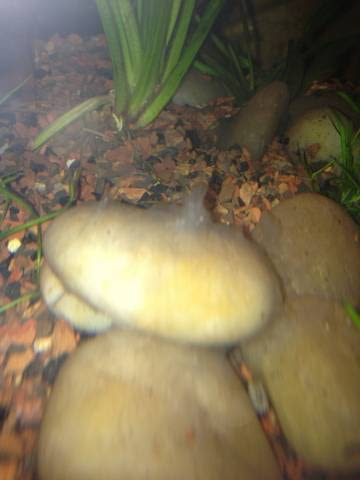 white fuzz on aquarium stones
Question
Fuzz
Hi Jaymie, I recently set up a Hag
white fuzz on aquarium stones
Question
Fuzz
Hi Jaymie, I recently set up a Hag
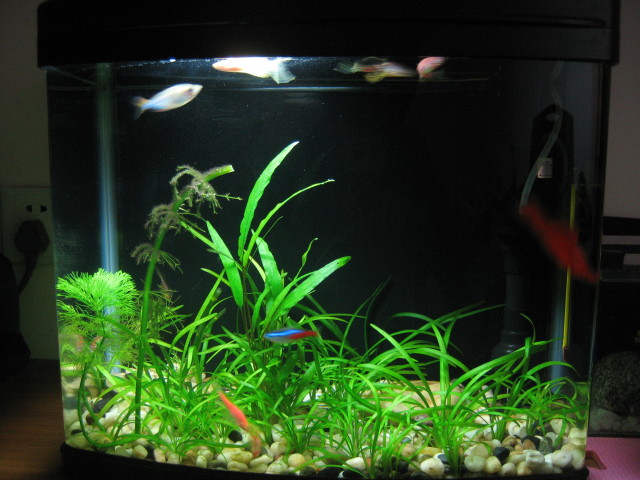 Tiny white organisms in my tank
Question
Fish tank
Hi Jaymie,
I recently found out some
Tiny white organisms in my tank
Question
Fish tank
Hi Jaymie,
I recently found out some
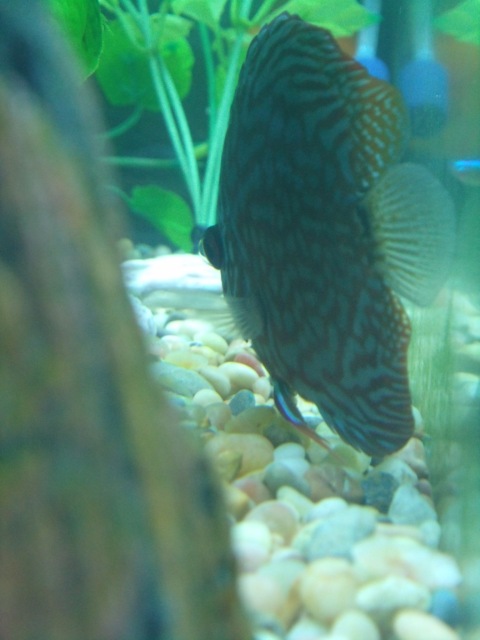 DISCUS with bulging clear eyes
Questionpop eye?
QUESTION: Okay quick run down
DISCUS with bulging clear eyes
Questionpop eye?
QUESTION: Okay quick run down
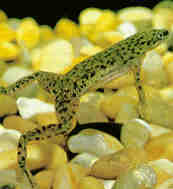 native freshwater fish
QuestionI am considering putting up a freshwater tank f
native freshwater fish
QuestionI am considering putting up a freshwater tank f
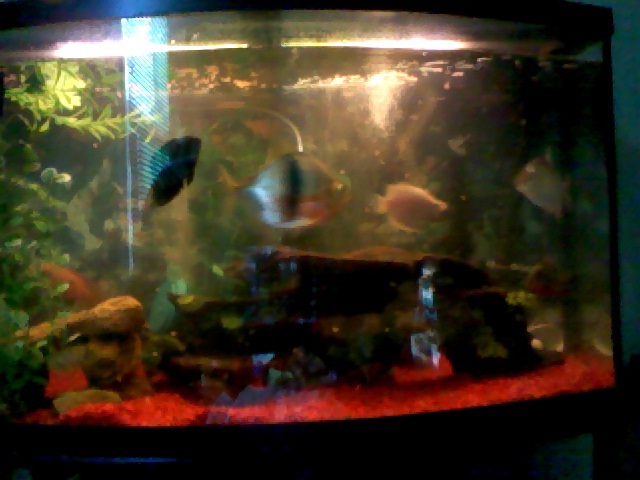 is my tank over stocked
Question
my tank
is my tank over stocked ...
1 jewel ci
is my tank over stocked
Question
my tank
is my tank over stocked ...
1 jewel ci